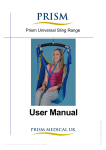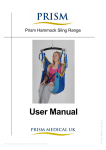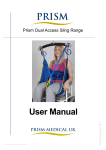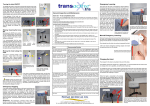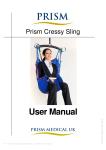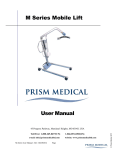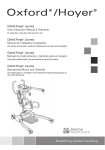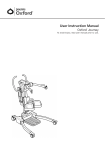Download Dual Access User Guide - April 2010
Transcript
Prism Dual Access Sling Range PL2 - Prism Dual Access User Guide - Doc 002 - Rev 04/2010 © Prism Medical UK 2010 User Manual Prism Dual Access Sling Application The Dual Access Sling is designed to be used from a sitting position with either a patient lifting hoist or a Standaid. The sling gives access to remove and refit lower garments for toileting transfers whilst the client is supported by the sling. This sling can make toileting less time consuming than if performing the manoeuvre with a Universal Sling however the person must have the ability to maintain a 90 degree position between their femur and pelvic girdle. Please read all instructions in full, including the back page, before you pro Sling Inspection All Prism slings are manufactured to meet and exceed the requirements of BS EN 10535:2006. Slings should be inspected prior to use and after washing. Damaged or badly worn slings should be discarded.. The label on the sling contains vital information to identify the sling—if any part of the label becomes illegible, then it must be removed from service and replaced. The sling should be visually inspected with regard to the following items:• Any signs of damage (i.e. Cuts, frays, tears, burns) to the sling straps. • Any signs of stitching becoming undone on any part of the sling. • Any signs of the fabric being stretched, tearing or undue wear. • Any signs of discolouring or bleaching on the material. • Is the sling complete? i.e. All straps present, stiffeners in place - where applicable, etc. • Label clearly legible. Compatibility The issue of sling compatibility with various manufacturers’ hoists has been a concern for specifiers for a number of years, an issue that is compounded by the increased number of companies supplying hoists and slings. Some hoist/sling manufacturers will state that only slings manufactured by them can be used on their hoists and vice versa. This is their policy only and is NOT a legal requirement. A risk assessment must still be completed even if the same manufacturer of hoist and sling are to be used, and the specifier simply has to state that the carry bar is of a similar design and that the sling manufacturer has authorised its use on it. A comprehensive list is available separately and your local agent will be able to provide assistance with compatibility issues. The maximum load for the sling is clearly marked on the label of the sling. The maximum load will also be displayed on the hoist and any detachable elements of the hoisting system. DO NOT exceed the maximum load stated on any of the equipment. PL2 - Prism Dual Access User Guide - Doc 002 - Rev 04/2010 © Prism Medical UK 2010 Maximum Load (Safe Working Load - S.W.L) Sling Dimensions D C A A B C D Child 630 410 220 680 Junior 730 510 220 760 Small 800 580 220 860 Medium 940 720 220 970 Large 1070 780 270 1170 X Large 1170 900 270 1340 All dimensions have a tolerance of +/- 20mm PL2 - Prism Dual Access User Guide - Doc 002 - Rev 04/2010 © Prism Medical UK 2010 B Hoisting from a chair Note: The person to be transferred shall be referred to as “the person”. 1 Bring the two sections of the support strap around the person’s trunk and fasten securely using the hook & loop and buckle fastening. Note: the support strap is purely intended for the security of the person and is not weight bearing. 3 The leg sections must now be passed under the thighs using good manual handling techniques (this can sometimes be achieved by placing the person’s foot onto your thigh). Ensure that as much leg section as possible is pulled under the leg and that all creases are eliminated to achieve maximum comfort. 4 Important - At the base of the leg section strap there is a loop. Bring the straps together by passing one strap through the loop. The fitting of the sling is now complete. The four straps should now be attached to the carry bar hooks. Raise the carry bar just enough to tension the straps and ensure that they are still securely attached. HOW TO FIT FROM SEATING POSITION b To remove the sling, carry out the fitting procedure in reverse. Important - always peel the sling away from the person to avoid skin friction and movement. PL2 - Prism Dual Access User Guide - Doc 002 - Rev 04/2010 © Prism Medical UK 2010 Place the sling down the back to a position just beneath the shoulder blades and above the belt line. If the sling can not be introduced from behind, apply the sling in a position level with the person. 2 Hoisting from a chair - Continued As the person is about to be lifted check the support strap for tension and comfort. Re-adjust when required . 5 Important - always re-assess for client’s co-operation and capability when using this sling. To remove the sling, carry out the fitting procedure in reverse. Important - always peel the sling away from the person - this avoids skin friction and movement. Optional - Side Retention Strap Follow procedures 1-3. When using the optional hip retention strap, fasten the buckle and adjust tension to suit. Follow procedures 4 & 5 Raise the carry bar just enough to tension the straps, make final adjustment to the hip retention strap and ensure that the lifting straps are still securely attached. How to use with a Standaid Follow procedures 1- 4 Raise the carry bar just enough to tension the straps and ensure that they are still securely attached. The person can now be lifted as required. To remove the sling, carry out the fitting procedure in reverse. Important - always peel the sling away from the person to avoid skin friction and movement. PL2 - Prism Dual Access User Guide - Doc 002 - Rev 04/2010 © Prism Medical UK 2010 Place the person’s feet onto the foot plate and adjust the kneepad (the kneepad should be positioned at the top of the shin avoiding the knee joint) the four straps should now be attached to the carry bar. CE Marking - Declaration of Conformity Registered Manufacturer No: CA003907 Prism UK Medical hereby declares that the Prism sling range meets the provisions of the European Union Council Directive 2007 / 47 / EEC concerning medical devices and are classified as Class 1 devices in accordance with that Directive. Prism - Dual Access Sling We hereby certify that the products listed above are manufactured, labelled and packaged in accordance with the provisions of Directive 2007 / 47 / EEC and conform in all aspects to the specification(s) relevant to them at the time of despatch and are CE marked in accordance with Directive 2007 / 47 / EEC . ……………………………. Signed : For Prism Medical UK Prism Universal Prism Hammock Prism Deluxe Prism Comfort Recline PL2 - Prism Dual Access User Guide - Doc 002 - Rev 04/2010 © Prism Medical UK 2010 A full range of Prism slings are available - A small selection are featured below SLING CARE: LAUNDERING GENERAL. Sensitive laundering of lifting slings will extend the service life of the product. Conversely, improper laundering will reduce the service life and possibly affect the strength and integrity of the sling. To be avoided: • use of bleach at washing, particularly hypochlorite [may cause structural damage] • overheating the sling [temperatures in excess of 100º may cause extreme shrinkage and structural damage] Use of biological detergents is not recommended: though this type of detergent has no detrimental effect on the sling, the user’s skin may be sensitive to any residue. The use of fabric conditioners is not recommended. Any hook & loop fastenings should be closed prior to laundering to avoid the ‘hook’ side damaging the sling or other items laundered with it. GENERAL SOILING. The sling should be laundered with soap or detergent at 50°C on a standard domestic cycle. DISINFECTION. The sling should be laundered to ensure a ‘period at temperature’ of: • 10 minutes at 65ºC • 3 minutes at 72ºC Following NHS guidelines, extra time should be added to ensure thorough mixing of hot water through the wash load. It may be that available equipment does not allow the required level of temperature control. The sling may be washed on a 90ºC wash cycle, though it is likely that some moderate shrinkage and/or colour bleed will occur. DRYING. Do not allow the sling to overheat. The sling should last in excess of 5 years if the above guidelines are adhered to. All Prism slings have a manufacturers guarantee of 12 months. PL2 - Prism Dual Access User Guide - Doc 002 - Rev 04/2010 © Prism Medical UK 2010 Slings will air dry quite quickly in a warm room. Slings should not be placed over radiators or convectors. Slings may be CAREFULLY tumble dried on a cool [60ºC] setting and short cycle. The sling should be checked at intervals not exceeding 5 minutes. SLING SAFETY Care Plan Information All slings in the Prism range have space on the labels to record the clients name. Each sling has unique individually colour coded lifting loops which helps maintain good lifting practice. The loop options facilitate variable positions from sitting to recline. FIM Score: Date of Assessment : Clients Name: Approx Weight: D.O.B: Type of Sling: Size: Sling Straps Coloured loop Options Head Support (Option): Adjust slider to suit the persons head position Shoulder Loop: White Leg loop: Yellow Orange Blue Other Green Brown Other Comments Integra 200, St Asaph Business Park, St Asaph, Denbighshire, LL17 0LJ Tel +44 (0) 845 409 2000 Fax +44 (0)1745 582532 www.prismmedical.co.uk [email protected] This document conforms to BS EN ISO 10535:2006 Requirements PL2 - Prism Dual Access User Guide - Doc 002 - Rev 04/2010 © Prism Medical UK 2010 If you have any questions regarding the use of this equipment, please contact Prism Medical UK, or your local authorised dealer.









